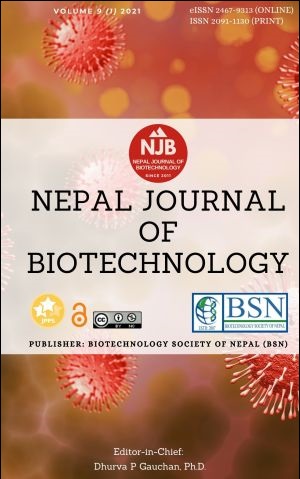Antibiotic Susceptibility Pattern of Staphylococcus aureus Isolated from Pus/Wound Swab from Children Attending International Friendship Children's Hospital
DOI:
https://doi.org/10.3126/njb.v9i1.38645Keywords:
Pus/wound swab, Staphylococcus aureus, Antibiotic susceptibility test (AST), Multidrug resistance (MDR), Methicillin resistance, MRSA, D-testAbstract
A wound gets infected when the organism gets invaded through the breached skin, proliferated and production of various enzymes, toxins, etc. In order to treat the wound infection, antibiotic susceptibility pattern of organism should be determined before the prescription of the medicine. The present study was conducted from September 2017 to March 2018 with an aim to determine antibiotic susceptibility pattern of Staphylococcus aureus identified from the pus/wound swab among the patients visiting the International Friendship Children's Hospital, Kathmandu, Nepal. Total 270 sample were processed, isolated and identified using standard microbiological procedure and biochemical test. Antibiotic susceptibility test was carried out by using Modified Kirby Bauer's Disc Diffusion Method. Out of total sample, 51.48% (139) showed growth. The growth distribution was found to be high in out-patient department 84.9% (118) than in-patient department 15.1% (21). Among 139 positive growth, 83.5% were gram positive and 16.5% were gram negative. All together 12 different organisms were identified, among which S. aureus was found to be predominant organism 105 (75.5%). S. aureus was found to be sensitive towards Linezolid followed by Doxycycline whereas it was found resistant towards Ciprofloxacin. Among S. aureus identified, 50% were Multidrug resistant (MDR) S. aureus and 55% were Methicillin resistance S. aureus (MRSA). MRSA was found to be sensitive towards Linezolid followed by Doxycycline and resistant towards Ciprofloxacin. The association between MDR and MRSA was found positively significant (i.e. p-value = 0.000). All strains of S. aureus were found to be sensitive towards Vancomycin. 22.86% were double disk diffusion test (D-test) positive. The prevalence of D-test was found to be high in MRSA (75%). The relationship between D-test and MRSA was found to be significantly correlated with each other (r = 0.39). Linezolid, Chloramphenicol, Vancomycin and Doxycycline is a drug of a choice for both S. aureus and MRSA infection.
Downloads
Downloads
Published
How to Cite
Issue
Section
License
Copyright (c) 2021 Biotechnology Society of Nepal

This work is licensed under a Creative Commons Attribution-NonCommercial 4.0 International License.
Copyright Notice:
The manuscript submitted to NJB must be an original contribution, not previously published and should not be under consideration for publication elsewhere. When the manuscript is accepted for publication, the authors agree to automatically transfer the copyright of the article to the publisher. It should grant permission to any third party, in advance and in perpetuity, the right to use, reproduce or disseminate your article, according to the NJB copyright and license agreement.
Authors transfer copyright to the publisher as part of a journal publishing agreement but have the rights to: Share their article for Personal Use, Internal Institutional Use and Scholarly Sharing purposes, with the NJB applies the Creative Commons Attribution-NonCommercial CC BY-NC license to all the works we publish after Jun 2020 (Before it was CC BY-NC-ND). Under this license, authors agree to make articles legally available for reuse, without permission or fees, for virtually any non-commercial purpose. Anyone may remix, adapt, and build upon your work non-commercially, and although their new works must also acknowledge you and be non-commercial, they don’t have to license their derivative works on the same terms. More details on CC BY-NC refer to its Licence Deed and Legal Code.






